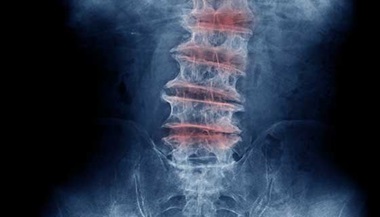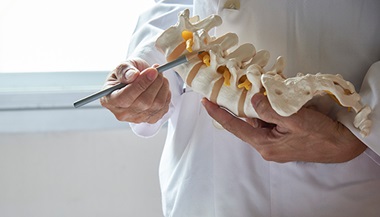Minimally Invasive Lumbar Discectomy
What is a lumbar discectomy?
Lumbar discectomy is a type of surgery to fix a bulging disk in the lower back. This surgery uses smaller cuts (incisions) than an open lumbar discectomy.
Your backbone, or spinal column, is made up of a chain of bones called the vertebrae. Your spinal cord runs through the spinal column. The bones help protect the cord from injury. Disks sit between each vertebra to provide cushioning and support. Large nerves called nerve roots lead from the spinal cord through small holes between the bones called foramen. These nerve roots send and receive signals to and from the body. The signals are sent to and from your brain through the spinal cord.
Sometimes the outer wall of one of these disks may dry out and weaken with age or injury. When this happens, the soft, inner part of the disk bulges out. This is called a herniated or bulging disk. This bulging disk can press on the nerve roots or sometimes on the spinal cord and cause symptoms such as pain, tingling, or weakness in parts of the body.
During a minimally invasive lumbar discectomy, an orthopedic surgeon or neurosurgeon takes out part of the damaged disk. This helps ease the pressure on the nerve root or spinal cord. Your surgeon can use different methods to do this. With one method, your surgeon inserts a small tube through the skin on your back, between the vertebrae and into the space with the herniated disk. They then insert tiny tools through the tube to remove a part of the disk. Or a laser may be used to remove part of the disk. Unlike an open lumbar discectomy, the surgeon makes only a very small skin incision and removes little if any bone or muscle.
Why might I need a lumbar discectomy?
You may need this surgery if you have a herniated disk in your lower back that is causing symptoms. The symptoms may include lasting weakness, pain, or tingling in the back area and in one of your legs.
Lumbar discectomy can’t be used to treat all cases of back pain. And not everyone with a herniated disk needs a lumbar discectomy. Your healthcare provider might advise the surgery if you’ve tried other treatments but still have severe symptoms. Other treatments to try first include physical therapy, epidural spinal injections (ESIs), and anti-inflammatory medicines.
Talk with your provider about the risks and benefits of minimally invasive surgery compared with open surgery. Minimally invasive surgery may lead to less pain and faster recovery. But not all surgery centers can use this method.
What are the risks of a lumbar discectomy?
Every surgery has risks. Risks for this surgery include:
-
Infection
-
Excess bleeding
-
Blood clots
-
Injury to nearby nerves
-
Reaction to anesthetic agents
-
Only short-term (temporary) relief and need for another surgery
Your risks may vary depending on your age and your general health. Talk with your provider about the risks that most apply to you.
How do I get ready for a lumbar discectomy?
Ask your healthcare provider how you should plan to prepare for your procedure. Ask if you should stop taking any medicines ahead of time, like blood thinners. Follow any directions you are given for not eating or drinking before your procedure.
Your provider may order other imaging tests of your spine, such as an MRI.
What happens during a lumbar discectomy?
There are several options for the surgery. Your surgeon can help explain the details of your procedure. It may take about 1 hour. Here is an example of what you might expect:
-
You will receive a local anesthetic so that you won’t feel any pain or discomfort during the procedure. And you will still be awake. Or you may have general anesthesia and sleep through the procedure.
-
A healthcare provider will carefully watch your vital signs during the procedure. This includes things like your heart rate and blood pressure.
-
Your surgeon will make a small incision on your back, at the level of the affected disk.
-
During the procedure, your surgeon will use a special type of X-ray to make sure of the correct location.
-
Your surgeon will first insert a small rod on top of the intervertebral space. Your surgeon will push a slightly larger tube over this rod. Then your surgeon will push a second, larger tube over that one. They may even push a third tube over the second one. This will gently push apart the tissue down to the vertebra. Finally your surgeon will remove all except the largest tube.
-
Your surgeon will put special small tools through this tube, including a camera and a light.
-
Your surgeon will remove the herniated part of the disk using small tools. They will also do any other needed repairs.
-
The tools and tube are removed.
-
A small bandage is placed to close your wound.
Thoracic Disc Herniation: Pedro's Story

In 2017, Pedro could barely move. Other doctors told him he might never walk again. At Johns Hopkins, the message was different.
What happens after a lumbar discectomy?
The surgery is usually an outpatient procedure. This means you can go home the same day. You will probably need to stay for a couple of hours after the procedure. Make sure you have someone who can drive you home.
Your healthcare provider will give you instructions about how you can use your back. You might need to limit lifting or bending. Your provider might have you wear a back brace for a limited time after the procedure. Most people can go back to work within a week or so. You may need physical therapy after surgery to help strengthen your back.
You may see some fluid draining from your small incision. This is normal. Tell your provider right away if there is a large amount of drainage from the incision site. Also call your provider if you develop a fever or if you have a lot of pain in the area.
Sometimes the procedure causes slightly more pain for a while. But you can take pain medicines to ease the pain. Usually this goes away quickly. Your pain should become less than it was before your surgery.
Make sure to follow all your provider’s instructions and keep your follow-up appointments.
Next steps
Before you agree to the test or the procedure make sure you know:
- The name of the test or procedure
- The reason you are having the test or procedure
- What results to expect and what they mean
- The risks and benefits of the test or procedure
- What the possible side effects or complications are
- When and where you are to have the test or procedure
- Who will do the test or procedure and what that person’s qualifications are
- What would happen if you did not have the test or procedure
- Any alternative tests or procedures to think about
- When and how will you get the results
- Who to call after the test or procedure if you have questions or problems
- How much will you have to pay for the test or procedure






